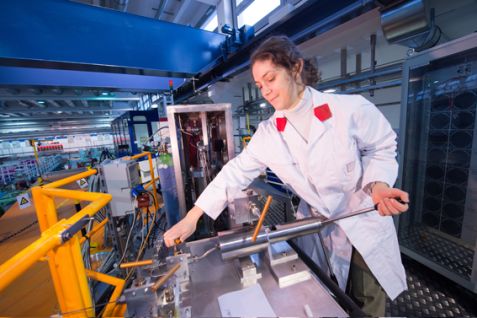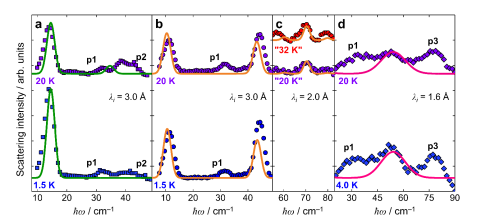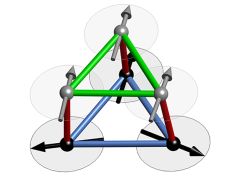MLZ is a cooperation between:
 > Technische Universität München
> Technische Universität München > Helmholtz-Zentrum Hereon
> Helmholtz-Zentrum Hereon
 > Forschungszentrum Jülich
> Forschungszentrum Jülich
MLZ is a member of:
 > LENS
> LENS > ERF-AISBL
> ERF-AISBL
MLZ on social media:

MLZ (eng)
Lichtenbergstr.1
85748 Garching
28.06.2018
Symmetry tuning in molecular nanomagnets:
Neutrons reveal the difference
Molecular nanomagnets represent quite promising systems for high-density storage devices and as building units in quantum computers (qubits). Key requirements for their large-scale industrial application are the storage efficiency and the storage reliability against internal and external perturbations. The first point owns to the number of achievable magnetic states on a single molecule, whereas the second one is intimately linked to the molecular symmetry. Indeed, the main source of memory loss results from electronic quantum fluctuations within the ground state of the molecule (so-called quantum tunneling). A Danish-based team of international researchers has now gauged the effect of a chemistry-induced symmetry change in lanthanides-based molecular nanomagnets, thus addressing both key requirements at once. The results, achieved via inelastic neutron scattering at the MLZ time-of-flight spectrometer TOFTOF and complementary techniques, recently appeared in Nature Communications and Advanced Functional Materials.
“For systems based on a single rare-earth ion, the storage capability is ruled by the interplay between the energetic structure of the crystal field levels and the quantum tunneling of unpaired electrons within the ground state of the molecule: only stable unpaired electrons grant a stable magnetic information”, explains Prof. Jesper Bendix, who coordinated the research project.
Inelastic neutron scattering represents a unique investigation tool for strong spin-orbit coupled systems, as the energy scale of the CF levels (ranging between few to tens of meV) naturally matches the thermal-cold dynamical range. It is therefore possible to directly tackle their evolution (position and resolution), while interacting with the magnetic sites.
“These investigations took really the best of the TOFTOF performance”, says Dr. Giovanna G. Simeoni, former scientist on charge of the TOFTOF. After devoting great efforts to the instrumental upgrade for magnetic and extreme-conditions studies, she can finally see the scientific impact of this development. The intrinsic peculiarity of TOFTOF with respect to other neutron spectrometers is its hybrid thermal-cold spectral range, bridging the gap between classical TOF and triple axis machines. Specifically, the measurements were carried out in the range 1.6 – 3 Å. “However, without the upgrade of the chopper system, it would have been impossible to get the necessary energy resolution”, she explains. “The extension of the detector area and the installation of the focusing neutron guide did the rest of the job.”
The secret of these materials relies on the chemical design, i.e. the ad hoc combination of the single ion magnetic anisotropy of lanthanide ions with the crystal field (CF) imposed by the ligands. The work of Prof. Bendix and his group, based at the Niels Bohr Institute and the Department of Chemistry at the University of Copenhagen, was aimed at assessing the interplay between CF levels of the ligands and f-orbitals of the rare-earth ions. After this thorough study, two complementary aspects were addressed.
Interplay between CF and localized magnetic moments: The role of f-orbitals in stabilizing the local magnetic structure
The group investigated the energetic structure of the crystal field levels of the molecules performing inelastic neutron scattering experiments at the MLZ instrument TOFTOF with Dr. Giovanna G. Simeoni. The PhD student Mikkel A. Sørensen, explains: “Inelastic neutron scattering is the perfect technique for such crystal field studies.”
Upon combining the information on the crystal field levels obtained from neutron scattering with information from complementary magnetometric investigations, the authors were able to relate the change in molecular symmetry to the alteration in the tunneling rate obtained from dynamic magnetic susceptibility measurements. “Our work demonstrates how the timescale of quantum tunneling in rare-earth molecular nanomagnets can be tuned by chemical means by targeting specific molecular symmetries”, Mikkel A. Sørensen explains. In this manner, the study paves the way for a more rational chemical design of new nanomagnets with tailor-made physical properties.

Dr. Giovanna G. Simeoni at the instrument TOFTOF at the MLZ neutron guide hall. © Volker Lannert / daad
Interplay between CF and localized magnetic moments: The role of f-orbitals in controlling the local magnetic structure
Magnetic anisotropy is the common denominator over many future applications related to lanthanide-based complexes. Axially anisotropic magnetic systems are frequently classified as easy axis or easy plane, depending on whether the lowest energy is obtained by application of a magnetic field parallelly or perpendicularly to the unique axis. Easy axis anisotropy is characteristic of Single Molecule Magnets while easy plane anisotropy is often exploited in Quantum Bits. For this reason, the full control over this property is a goal of great value in molecular magnetism.
It is common to assume that the magnetic anisotropy is univocally defined by two characteristics: I. the nature of the lanthanide ion and II. the coordination geometry imposed by the ligands. “We experimentally proved that this assumption is often wrong”, says Dr. Mauro Perfetti, who is the first author of the paper. “We were indeed able to switch magnetic anisotropy of a several mononuclear lanthanide complexes from easy axis to easy plane using temperature and magnetic field”. The effect is a molecular attribute related to a reshaping of the free energy due to the progressive population of states having different compositions, and it is thus fully reversible.
The paper demonstrates that the actual classification of magnetic anisotropy must delineate the experimental or simulation conditions (temperature and field) to avoid ambiguous conclusions. Moreover, the complexes under investigation are the first members of a new category of multifunctional materials.
Original publications:
Mikkel A. Sørensen, Ursula B. Hansen, Mauro Perfetti, Kasper S. Pedersen, Elena Bartolomé, Giovanna G. Simeoni, Hannu Mutka, Stéphane Rols, Minki Jeong, Ivica Zivkovic, Maria Retuerto, Ana Arauzo, Juan Bartolomé, Stergios Piligkos, Høgni Weihe, Linda H. Doerrer, Joris van Slageren, Henrik M. Rønnow, Kim Lefmann & Jesper Bendix
Chemical tunnel-splitting-engineering in a dysprosium-based molecular nanomagnet
Nat. Commun. 9, 1292 (2018) doi:10.1038/s41467-018-03706-x
Mauro Perfetti, Mikkel A. Sørensen, Ursula B. Hansen, Heiko Bamberger, Samuel Lenz, Philipp P. Hallmen, Tom Fennell, Giovanna G. Simeoni, Ana Arauzo, Juan Bartolomé, Elena Bartolomé, Kim Lefmann, Høgni Weihe, Joris Slageren & Jesper Bendix
Magnetic Anisotropy Switch: Easy Axis to Easy Plane Conversion and Vice Versa
Adv. Func. Mater. (2018) doi: 10.1002/adfm.201801846
Seminar on this topic:
Dr. Mauro Perfetti
Magnetic molecules on demand: the key role of inelastic neutron scattering and torque magnetometry
Monday, 2 July 2018, HS 3, Physics Department
14.30-15.30h
Related News
MLZ is a cooperation between:
 > Technische Universität München
> Technische Universität München > Helmholtz-Zentrum Hereon
> Helmholtz-Zentrum Hereon
 > Forschungszentrum Jülich
> Forschungszentrum Jülich
MLZ is a member of:
 > LENS
> LENS > ERF-AISBL
> ERF-AISBL
MLZ on social media:




